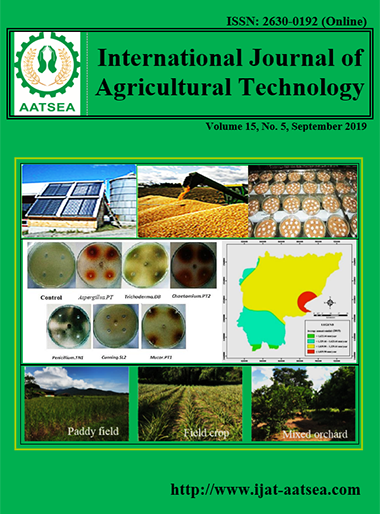Comparison of root system and stomata in nine upland rice varieties
Main Article Content
Abstract
The root system and stomata of upland rice have important implications for both nutrient uptake and drought tolerant. The drought is one of the most known limiting factors of crop cultivation during rainy season which is caused from the climatic change. The root system and stomata in nine upland rice varieties:- Pukaotong, Samduen, Lebnok, Nangdam, Dokkam, Nangkruan, Nangchuan, Lebmuenang and Dawk Pa-yawm was reported. Result found that root system and stomata were associated with drought tolerance of upland rice. Among the nine upland rice varieties, Pukaotong variety had the moderate plant height, root length, root thickness number root and number stomata. On the other hand, Pukaotong variety had the lowest length of long cell and high yield per plant, indicating the high drought tolerance ability.
Article Details

This work is licensed under a Creative Commons Attribution-NonCommercial-NoDerivatives 4.0 International License.
References
Biswas, C. D., Biswas, B. K., Abu Sadat, Md., Saha, P. S. and Zablul Tareq, Md. (2018). Morphological comparison among upland and lowland rice varieties for development of drought resistant variety. International Journal of Business, Social land and Scientific Research, 6:96-102.
Boonjung, H. and Fukai, S. (1996). Effects of Soil Water Deficit at Different Growth Stages on Rice Growth and Yield under Upland Conditions. Field Crops Research, 48:47-55.
Chang, T. T. (1976). The origin, evolution, cultivation, dissemination and diversification of Asian and African rices. Euphytica, 25:425-441.
Fageria, N. K. (2001). Nutrient management for improving upland rice productivity and sustainability. Commun. Soil Science and Plant Analysis, 32:2603-2629.
Jones, H. G. (1998). Stomatal control of photosynthesis and transpiration. Journal of Experimental Botany, 49:387-398.
Lestari, E. G. (2006). The relation between stomata index and drought resistant at rice somaclones of Gajahmungkur, Towuti, and IR 64. Biodivesitas, 7:44-48.
Padmini, S., Anitha, R., Singhc, S. P. and Kumar, A. (2017). Breeding drought tolerant rice for shallow rainfed ecosystem of eastern India. Field Crops Research, 209:168-178.
Pantuwana, G., Fukaib, S., Cooperb, M., Rajatasereekulc, S. and O'Toole, J. C. (2002). Yield response of rice (Oryza sativa L.) genotypes to drought under rainfed lowland 2. Selection of drought resistant genotypes. Field Crops Research, 73:169-180.
Raumjit, N. and Thirayut, W. (2013). Quality of upland rice seed production during the rainy season in southern Thailand. International Journal of Plant, Animal and Environmental Sciences, 3:181-184.
Raumjit, N. and Thirayut, W. (2015). Effects of zeolite on seed quality of organic upland rice. Research Journal of Applied Sciences, Engineering and Technology, 11:879-884.
Sarwar, A. K. M. Golam and Ali, M. A. (2002). Studies on the leaf epidermis of rice (Oryza sativa L.). Indian Journal of Agricultural Research, 36:24-28.
Sharp, R. E and Da vies, W. J. (1985). Root growth and water uptake by maize plants in drying soil. Journal of Experimental Botany, 36:1441-1456.
Xu, Z. and Zhou, G. (2008). Responses of leaf stomatal density to water status and its relationship with photosynthesis in a grass. Journal of Experimental Botany, 59:3317-3325.
Yoshida, S., Bhattacharjee, D. P. and Cabuslay, G. S. (1982). Relationship between plant type and root growth in rice. Soil Science and Plant Nutrition, 28:473-482.


